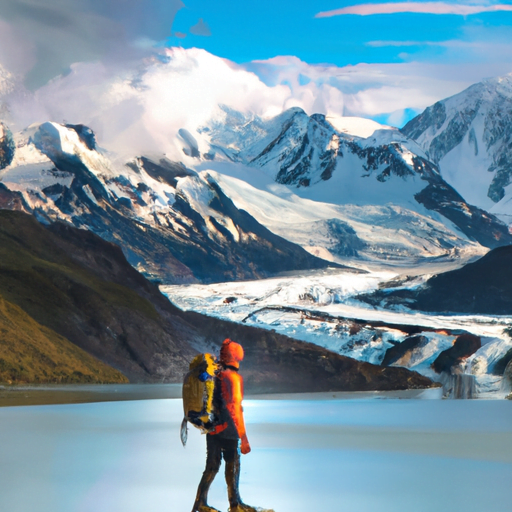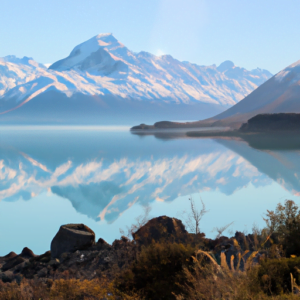Discover how you can enjoy the breathtaking beauty of Alaska’s pristine wilderness while also playing a crucial role in supporting conservation efforts. This article explores practical tips and strategies for practicing sustainable travel in Alaska, highlighting the importance of minimizing your environmental impact and respecting the delicate ecosystem. By adopting a responsible approach to your Alaskan adventure, you can help protect this remarkable landscape for future generations to enjoy. So, grab your gear and get ready to embark on an unforgettable journey that promotes sustainability and preserves the natural wonders of Alaska.
Table of Contents
ToggleSustainable Travel in Alaska: Transportation
Use eco-friendly transportation options
When embarking on your sustainable travel journey in Alaska, consider using eco-friendly transportation options. One great choice is to make use of bicycles or electric bikes to explore the local surroundings. This not only reduces your carbon footprint but also allows you to experience the breathtaking beauty of Alaska at a slower pace. Another eco-friendly transportation option is electric cars or hybrid vehicles, which can be rented from various rental agencies. By opting for these alternatives, you can significantly reduce your impact on the environment while enjoying the wonders of Alaska.
Utilize public transportation
Using public transportation is another great way to practice sustainable travel in Alaska. Public buses and trolleys are available in many cities and towns, offering convenient transportation options for both locals and visitors. By utilizing public transportation, you can contribute to reducing the number of private vehicles on the road, minimizing traffic congestion and air pollution. Not only will you be supporting the local transportation infrastructure, but you will also have the opportunity to interact with the local community and gain a deeper understanding of Alaska’s culture and way of life.
Carpool or share rides
If using private transportation is unavoidable, consider carpooling or sharing rides with fellow travelers. Alaska has several online platforms and applications that connect people looking to share rides. Carpooling not only helps reduce the number of vehicles on the road but can also foster new connections and friendships during your trip. Additionally, sharing the cost of fuel and parking can help you save money while contributing to sustainable travel efforts. Prioritizing carpooling or ride-sharing is a simple yet effective way to minimize your carbon emissions and make your trip to Alaska more eco-friendly.
Accommodation
Stay in eco-friendly lodges or cabins
When choosing accommodations during your sustainable travel in Alaska, opt for eco-friendly lodges or cabins. These establishments are designed with sustainability in mind, often utilizing renewable energy sources and implementing green practices. Many eco-lodges and cabins are nestled in remote areas, providing a unique opportunity to experience the natural beauty of Alaska while minimizing your impact on the environment. By selecting accommodations that promote sustainable practices, you are supporting businesses that prioritize environmental conservation and responsible tourism.
Choose accommodations with green certifications
Another aspect to consider when selecting accommodations in Alaska is their green certifications. Certifications such as LEED (Leadership in Energy and Environmental Design) or Energy Star indicate that the establishment has met certain environmental standards. These certifications take into account energy efficiency, water conservation, waste management, and overall environmental impact. Choosing accommodations with green certifications ensures that your stay in Alaska aligns with your commitment to sustainable travel and supports businesses dedicated to environmental responsibility.
Reduce energy consumption in your room
While staying in your chosen accommodation, you have the power to further reduce energy consumption. Simple actions such as turning off lights, television, and electronics when not in use can have a significant impact on energy conservation. Additionally, adjusting the thermostat to a slightly lower temperature during winter or a higher temperature during summer can help optimize energy usage. Choosing to reuse towels and linens instead of requesting fresh ones daily also contributes to minimizing water consumption. By being mindful of your energy and water usage, you actively participate in sustainable travel practices and contribute to the overall conservation efforts in Alaska.
Packaging and Waste
Pack lightly and bring reusable items
One of the fundamental principles of sustainable travel is packing lightly and bringing reusable items. By packing only what you need, you save both space and weight, which leads to reduced fuel consumption during transportation. When selecting your wardrobe, consider versatile clothing items that can be mixed and matched. Additionally, bringing reusable water bottles, utensils, and shopping bags can help minimize single-use plastics and reduce waste. These simple actions play a crucial role in preserving the pristine wilderness of Alaska, ensuring that future generations can also enjoy its beauty.
Avoid single-use plastics
In your effort to practice sustainable travel in Alaska, it is essential to avoid single-use plastics. Plastic waste poses a severe threat to the environment, particularly in fragile ecosystems like Alaska. Instead of using plastic water bottles, opt for reusable bottles and refill them at water stations or taps. Bring your own travel mug for hot beverages instead of using disposable cups. Say no to plastic straws and choose alternatives made of metal or bamboo. By consciously avoiding single-use plastics, you actively contribute to the preservation of Alaska‘s pristine nature and protect the well-being of its wildlife.
Properly dispose of waste and recycle
Responsible waste management is a crucial component of sustainable travel in Alaska. When visiting natural areas, it is essential to follow the principle of “leave no trace” and ensure that all waste is properly disposed of or carried out. This involves bringing a small bag for collecting any trash and disposing of it in designated bins. Be mindful of separating recyclable materials from general waste and make use of recycling facilities whenever available. By taking the extra effort to properly dispose of waste and recycle, you help maintain the cleanliness and ecological integrity of Alaska’s stunning landscapes.
Wildlife Viewing
Observe wildlife from a distance
Alaska is home to a rich and diverse array of wildlife, making it a popular destination for nature enthusiasts. When engaging in wildlife viewing activities, it is crucial to observe animals from a respectful distance. Approaching wildlife too closely can cause stress and disrupt their natural behaviors. Use binoculars, spotting scopes, or zoom camera lenses to observe wildlife without intruding on their space. By maintaining a safe distance, you not only protect the well-being of the animals but also ensure your own safety.
Follow responsible wildlife viewing guidelines
To further promote sustainable travel, it is important to follow responsible wildlife viewing guidelines. These guidelines are designed to minimize disturbance to wildlife and their habitats. Some general principles include not approaching nesting sites or dens, avoiding sudden or loud noises, and refraining from using flash photography. Familiarize yourself with specific guidelines for different species, such as keeping a safe distance from marine mammals or seabird colonies. By adhering to these guidelines, you contribute to the long-term conservation of Alaska’s precious wildlife.
Do not feed or disturb animals
While encountering wildlife during your travels in Alaska can be an awe-inspiring experience, it is essential to remember that feeding or disturbing animals is harmful and should be avoided. Feeding wildlife disrupts their natural foraging patterns and can create dependencies on human sources of food. This can lead to negative consequences for both the animals and the ecosystem as a whole. Respect the natural behavior of wildlife and allow them to find their own food sources. By resisting the temptation to interact with or feed animals, you contribute to the preservation of their wild nature and promote sustainable travel practices.
Outdoor Activities
Stick to designated trails
When engaging in outdoor activities in Alaska, such as hiking or trail running, it is important to stick to designated trails. These trails are carefully planned to minimize impact on the surrounding environment and protect sensitive habitats. Straying from designated pathways can lead to trampling vegetation, causing erosion, and disturbing wildlife. By following designated trails, you ensure that your outdoor adventures have minimal impact on Alaska’s fragile ecosystems.
Minimize your impact on flora and fauna
While exploring the great outdoors, make a conscious effort to minimize your impact on the flora and fauna of Alaska. Avoid picking flowers or disturbing plants, as they play a vital role in the ecosystem and provide habitats for various species. Be mindful of the fragile lichens and mosses often found in alpine areas. Additionally, when encountering wildlife, keep a safe distance and refrain from approaching or touching them. By respecting the natural environment and minimizing your impact, you contribute to the preservation of Alaska’s unique biodiversity.
Leave no trace by packing out garbage
The principle of “leave no trace” is a fundamental concept in sustainable travel and outdoor activities. It emphasizes the importance of leaving natural areas as you found them and packing out any garbage or waste. Carry a small bag for collecting any trash during your outdoor adventures and dispose of it properly in designated bins. Avoid leaving any food scraps behind, as they can disrupt natural foraging patterns and attract unwanted wildlife. By adhering to the principle of “leave no trace,” you respect the pristine wilderness of Alaska and ensure that future visitors can enjoy its beauty as well.
Support Local Conservation Organizations
Donate to local conservation groups
One of the most impactful ways to support conservation efforts in Alaska is by donating to local conservation groups. These organizations work tirelessly to protect the state’s unique ecosystems, wildlife, and cultural heritage. Research reputable conservation organizations that align with your values and make a contribution to their cause. Your donation will help fund vital conservation projects, environmental education programs, and wildlife rehabilitation efforts. By supporting these organizations, you actively contribute to preserving Alaska’s natural treasures for future generations.
Participate in volunteer programs
Another rewarding way to support conservation efforts is by participating in volunteer programs. Many local conservation organizations offer volunteer opportunities, ranging from habitat restoration projects to wildlife monitoring initiatives. These programs allow you to directly contribute your time and effort to conservation efforts while learning more about Alaska’s ecosystems and wildlife. Volunteering not only provides a valuable hand to these organizations but also offers a unique and immersive experience of Alaska’s natural wonders.
Learn about the work of conservation organizations
Educating yourself about the work of local conservation organizations is an important step in practicing sustainable travel in Alaska. Take the time to learn about the specific challenges facing the state’s ecosystems and the initiatives undertaken by conservation organizations to address them. Attend talks or workshops organized by these organizations, visit their visitor centers, or explore their websites to gain a deeper understanding of the issues at hand. By immersing yourself in the knowledge provided by these organizations, you become an informed advocate for Alaska’s conservation efforts.
Respect Indigenous Culture
Educate yourself about indigenous cultures
Alaska is home to diverse indigenous cultures with rich traditions and history. Respecting and appreciating these cultures is an essential aspect of sustainable travel. Educate yourself about the indigenous peoples of Alaska, their traditions, and their contributions to the state’s cultural heritage. Read books, watch documentaries, or engage in cultural exchange programs to learn from indigenous communities directly. By fostering understanding and respect, you contribute to the preservation and promotion of indigenous cultures in Alaska.
Seek permission before entering indigenous land
If you plan to visit areas of Alaska that are considered indigenous land, it is important to seek permission before entering. Many indigenous communities have their own rules and protocols for accessing their territories, sacred sites, or cultural events. Prioritize engaging with local indigenous leaders or community members to seek guidance and gain an understanding of the appropriate practices. By showing respect and seeking permission, you contribute to building positive relationships with indigenous communities and honoring their rights.
Respect traditional practices and sacred sites
When visiting areas with cultural or spiritual significance to indigenous communities, it is crucial to respect their traditional practices and sacred sites. Observe any posted regulations or signs and follow them accordingly. Refrain from touching or removing any artifacts or items of cultural significance. Avoid interrupting or intruding on ceremonies or events unless specifically invited to participate. By showing respect for traditional practices and sacred sites, you demonstrate your commitment to sustainable travel and cultural preservation in Alaska.
Responsible Fishing
Follow fishing regulations and guidelines
Alaska offers excellent fishing opportunities, but it is essential to fish responsibly and follow fishing regulations and guidelines. Familiarize yourself with the specific fishing regulations for the area you plan to visit, including catch limits, size restrictions, and seasonal closures. Respect these regulations to ensure the long-term sustainability of fish populations and their habitats. By obeying fishing regulations, you contribute to the conservation efforts aimed at preserving Alaska’s fisheries for future generations.
Practice catch-and-release fishing
To further support sustainable fishing practices, consider practicing catch-and-release fishing whenever possible. Catch-and-release fishing involves catching a fish and releasing it back into the water unharmed. This allows fish to reproduce and maintain healthy population levels while still providing anglers the thrill of the catch. Utilize barbless hooks and handle fish with wet hands or gloves to minimize stress and injury. By practicing catch-and-release fishing, you actively contribute to the sustainability of Alaska’s fish populations.
Minimize fish handling and stress
Minimizing fish handling and stress is crucial for sustainable fishing in Alaska. When handling a fish, be gentle and avoid exposing it to unnecessary stress. Quick and efficient catch-and-release techniques help minimize the risk of injury or exhaustion. Avoid excessive handling, which can remove the protective slime layer on fish, making them vulnerable to infection or disease. By minimizing fish handling and stress, you prioritize the health and well-being of Alaska’s fish populations and support sustainable fishing practices.
Reduce Energy Consumption
Turn off lights and electronics when not in use
A simple yet effective way to reduce energy consumption during your travels in Alaska is to turn off lights and electronics when not in use. Make it a habit to switch off lights when leaving your accommodation or a room, even if you plan to return shortly. Unplug chargers, power strips, and other electronic devices that continue to draw power even in standby mode. By eliminating unnecessary energy usage, you contribute to the overall reduction of greenhouse gas emissions and support sustainable travel practices.
Limit water usage
Conserving water is another essential aspect of sustainable travel in Alaska. The state’s abundant freshwater resources should not be taken for granted. Be mindful of your water usage by taking shorter showers, turning off the tap while brushing your teeth, and using water-saving techniques when doing laundry or washing dishes. Reusing towels and linens instead of requesting fresh ones daily is another effective measure to conserve water. By limiting water usage, you help preserve this precious resource and support sustainable travel in Alaska.
Optimize heating and cooling systems
Your choices regarding heating and cooling systems can significantly impact energy consumption. During the colder months, adjust the thermostat to a slightly lower temperature and wear additional layers or use blankets to stay warm. In warmer weather, opt for natural ventilation and use fans instead of air conditioning whenever possible. Close curtains or blinds during the hottest part of the day to reduce heat gain. By optimizing heating and cooling systems, you promote energy efficiency and reduce your ecological footprint while enjoying your sustainable travel experience in Alaska.
Minimize Carbon Footprint
Offset your travel emissions
Offsetting your travel emissions is an effective way to minimize your carbon footprint during your journey in Alaska. Consider participating in carbon offset programs offered by reputable organizations. These programs calculate the carbon emissions resulting from your travel and provide opportunities to invest in environmental projects that reduce or absorb an equivalent amount of carbon dioxide. Projects can include reforestation efforts, renewable energy initiatives, or methane capture programs. By offsetting your travel emissions, you actively contribute to the fight against climate change and support sustainable travel practices.
Choose eco-friendly activities and tours
When planning your itinerary in Alaska, prioritize eco-friendly activities and tours that align with sustainable travel principles. Opt for guided tours provided by local operators who emphasize environmental responsibility and conservation education. Explore options such as wildlife observation, hiking, kayaking, or visiting nature reserves that promote the protection of Alaska’s unique ecosystems. Avoid activities that involve high levels of resource consumption or have negative impacts on the environment. By choosing eco-friendly activities and tours, you ensure that your travel experiences in Alaska leave a minimal ecological footprint.
Use sustainable clothing and gear
The clothing and gear you choose for your Alaskan adventure can also contribute to sustainable travel. Opt for clothing made from sustainable and eco-friendly materials, such as organic cotton or recycled polyester. These materials reduce the environmental impact associated with conventional production methods. Choose gear that is durable and versatile, minimizing the need for frequent replacements. When purchasing outdoor equipment, consider products made from recycled or sustainable materials. By using sustainable clothing and gear, you support the circular economy and minimize waste while enjoying your sustainable travel experience in Alaska.
Sustainable Travel in Alaska: How to enjoy the pristine wilderness responsibly and support conservation efforts.
When it comes to sustainable travel, there are many ways to enjoy the pristine wilderness of Alaska responsibly while supporting conservation efforts. By utilizing eco-friendly transportation options such as bicycles or electric cars, using public transportation, or carpooling, you can significantly reduce your carbon footprint. Additionally, staying in eco-friendly lodges or cabins and choosing accommodations with green certifications ensures that your stay aligns with environmental values. Reducing energy consumption in your room by turning off lights and electronics when not in use and practicing water conservation further contributes to sustainable travel practices.
Packaging and waste management should also be a priority. Packing lightly and bringing reusable items, while avoiding single-use plastics, helps minimize waste. Properly disposing of waste and recycling when possible are key to preserving Alaska’s pristine landscapes. When it comes to wildlife viewing, maintaining a respectful distance, following responsible wildlife viewing guidelines, and never feeding or disturbing animals are essential to protect their well-being and natural behaviors.
When engaging in outdoor activities, sticking to designated trails, minimizing impact on flora and fauna, and leaving no trace by packing out garbage are crucial practices. Supporting local conservation organizations through donations or participating in volunteer programs helps protect Alaska’s unique ecosystems and wildlife. Respecting indigenous culture by educating yourself, seeking permission before entering indigenous land, and respecting traditional practices and sacred sites is fundamental. When fishing, following regulations and practicing catch-and-release fishing while minimizing fish handling and stress ensures the sustainability of fish populations.
Energy conservation plays a significant role in sustainable travel. Turning off lights and electronics, limiting water usage, and optimizing heating and cooling systems are simple yet effective measures. To minimize your carbon footprint, offsetting travel emissions, choosing eco-friendly activities and tours, and using sustainable clothing and gear are recommended practices.
By following these guidelines, you can truly enjoy the wonders of Alaska while supporting conservation efforts and leaving a positive impact on the environment. Remember, sustainable travel is not only about experiencing the beauty of nature, but also about preserving it for future generations. Let’s ensure that Alaska’s pristine wilderness remains a treasure to be enjoyed by all, while actively supporting its conservation.





